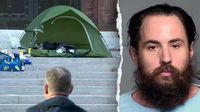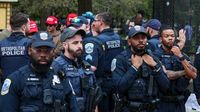On the morning of October 5, 2025, the steps of Washington, D.C.’s Cathedral of St. Matthew the Apostle—usually a place of solemn prayer and reflection—became the scene of a harrowing security scare. Police arrested Louis Geri, a 41-year-old man from Vineland, New Jersey, after discovering he had stashed more than 200 homemade explosive devices in a tent pitched outside the cathedral, just hours before the annual Red Mass was set to begin. The event, a tradition dating back 73 years, marks the start of the Supreme Court term and is typically attended by justices, diplomats, and a host of legal professionals.
According to The Washington Post, officers encountered Geri during routine security sweeps ahead of the Mass, which draws some of the nation’s most prominent legal figures. When asked to move his tent, Geri reportedly told police, “You might want to stay back and call the federales, I have explosives.” The tension only escalated from there. As officers attempted to negotiate, Geri warned, “Do you want me to throw one out, I’ll test one out on the streets? I have a hundred-plus of them.” He later threatened, “Several of your people are gonna die from one of these,” if they attempted to forcibly remove him.
The police, recognizing the potential severity of the threat, called in the Metropolitan Police Department’s bomb squad and cordoned off the area. In a tense exchange, a sergeant agreed to read a notebook Geri handed over, which was titled “Written Negotiations for the Avoidance of Destruction of Property via Detonation of Explosives.” The notebook, as described by The Washington Post and corroborated by Fox News, was filled with rants expressing hatred for the Catholic Church, Supreme Court justices, Jewish people, and the U.S. Immigration and Customs Enforcement (ICE). Geri’s animosity was described by authorities as “significant,” and his writings specifically targeted those expected to attend the Red Mass.
As the sergeant attempted to defuse the situation, Geri became more agitated. He reportedly pulled out several capped vials containing a yellow liquid—later identified as nitromethane, a volatile chemical used in the 1995 Oklahoma City bombing—and warned, “You better have these people step away or there’s going to be deaths.” Police retreated and formed a perimeter, maintaining a careful watch. Geri was ultimately apprehended after he left his tent to urinate near some trees, at which point officers seized the opportunity to handcuff him.
Inside Geri’s tent, the bomb squad discovered a massive cache of devices: glass vials filled with nitromethane, modified bottle rockets with aluminum foil heads, Molotov cocktails, and other items treated in pyrotechnic solutions. According to court documents cited by The Courier-Post and The Christian Post, the devices “appeared to be fully functional” and emitted a strong smell of acetone, a highly flammable solvent. Authorities described the collection as “a combination of parts designed or intended to be converted into a destructive device.” The explosives were seized and sent to the FBI for further testing, while the scene was declared secure by local law enforcement and the Explosive Ordinance Disposal team.
The discovery of Geri’s arsenal had immediate consequences for the day’s events. Several Supreme Court justices, who had been expected to attend the Red Mass, stayed away after learning of the potential threat. The Mass itself went ahead as scheduled, but the absence of the justices was keenly felt. According to the Catholic Standard, the official newspaper of the Roman Catholic Archdiocese of Washington, this marked a rare disruption in a tradition that has long served as a symbolic bridge between faith and the American legal system.
Further investigation revealed that Geri had previously been barred from the cathedral property on September 26, 2025, after refusing to move his tent from the steps. Despite the ban, he returned less than two weeks later, setting the stage for the dramatic events of October 5. The incident drew a swift and coordinated response from multiple agencies, including the FBI, the Bureau of Alcohol, Tobacco, Firearms and Explosives (ATF), and the Joint Terrorism Task Force, all of whom are now involved in the ongoing investigation.
Geri now faces a litany of charges: manufacture or possession of a weapon of mass destruction in furtherance of a hate crime, possession of a Molotov cocktail, threats to kidnap or injure a person, unlawful entry, assault on a police officer, resisting arrest, and making threats to kidnap or injure. A judge has ordered that he be held without bail, with a preliminary hearing scheduled for later this week. As Fox News reported, these charges are only allegations at this point; Geri has not yet been convicted.
The Cathedral of St. Matthew the Apostle, with its storied history as the Mother Church of the Catholic Archdiocese of Washington, has played host to numerous significant events, from presidential funerals to papal visits. The annual Red Mass, co-hosted by the John Carroll Society, is a centuries-old tradition that honors those who practice law and seeks divine guidance for the judicial system. Its name derives from the red vestments worn by celebrants and the color of fire, symbolizing the Holy Spirit.
Geri’s arrest has rattled both the local and national communities, raising questions about security at high-profile religious and civic events. The fact that the devices included materials similar to those used in major domestic terror attacks underscores the seriousness of the threat. As The Christian Post noted, the investigation remains active, with federal and local authorities combing through evidence and Geri’s writings to determine whether he acted alone or as part of a broader network.
While the swift response by law enforcement prevented what could have been a catastrophic attack, the incident serves as a sobering reminder of the vulnerabilities facing public gatherings—even those rooted in centuries-old tradition and faith. As the legal process unfolds, the community is left to grapple with the unsettling reality that hatred and violence can find their way to even the most sacred of spaces. For now, the Cathedral of St. Matthew the Apostle stands as both a symbol of resilience and a call for vigilance in the face of extremism.


